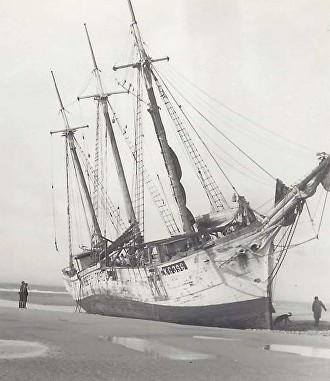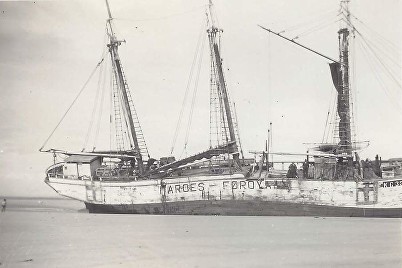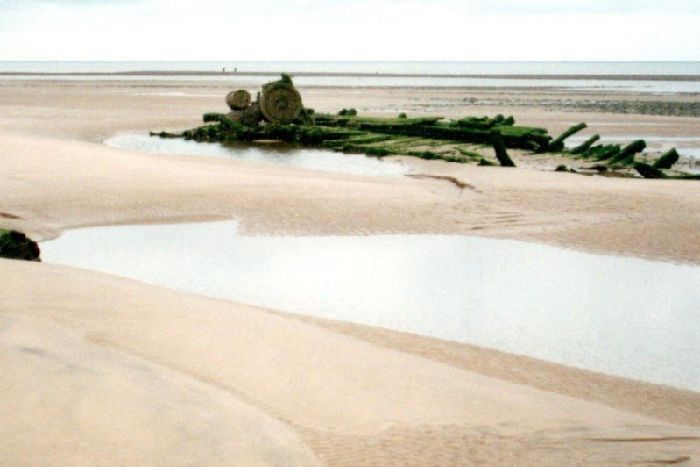

Note that when Denmark was invaded by Germany in April 1940, British forces occupied the Faroe Islands (which were then part of Denmark) to prevent them falling into German hands.
Report from the Lifeboat Magazine
SILVER MEDAL SERVICE AT FLEETWOOD AUGUST 5TH 1941 - FLEETWOOD, LANCASHIRE.
On the 4th of August, 1941, a half gale was blowing from the north-north-west, with squalls and a rough sea. A three-masted motor schooner of 300 tons, the Stella Marie, manned by Faroe Islanders, arrived off the harbour. She was loaded with fresh fish from Ireland to the value of £10,000. She anchored near the examination vessel, some four miles from the harbour, and could be seen there, riding uneasily to her anchor.
During the evening the weather got worse, and the Stella Marie tried to weigh anchor with the intention of making the harbour, but either the windlass broke down, or the anchor was fouled. She had to remain at anchor all night. Next morning her cable parted and she began to drift.
Then her main engine broke down.
Her crew, who had been working all night, were tired out, and they were very glad to accept an offer from the examination vessel to give them a tow. Unfortunately the hawser parted and the schooner started to drift again.
At last, at 10.30 in the morning, seeing that the schooner was again adrift, the resident naval officer asked the life-boat crew to stand by. The crew in fact had been standing by, in the life-boathouse, since early in the morning. They were all Fleetwood fishermen. They knew very well what was likely to happen. They uneasily watched the unavailing efforts which were being made to help the schooner, and they were not too pleased at the delay on the part of the resident naval officer in calling out the life-boat, for they well knew that time was very important, and that every minute's delay was making their own job, when they were called out, more difficult and dangerous.
Shortly after asking them to stand by at 10.30, the resident naval officer asked them to launch, but at the last moment he cancelled it. Half an hour later he again asked the life-boat to launch, and again cancelled it. It was not until 12.45 in the afternoon that the word was finally given, and at last the motor life-boat Ann Letitia Russell got away. She had a crew of six instead of the usual eight men.
A strong gale was now blowing, and the ebb tide was running against it, causing a high and very confused sea.
While he had been waiting for the order to launch the coxswain had thought out how he would act, knowing that speed would be imperative, and he drove the life-boat as hard as he could through the heavy seas at the grave risk of washing his own crew overboard. The life-boat was so enveloped by the seas that those who were watching her from the shore could hardly follow her on her journey.
In half an hour she reached the schooner, but by that time the schooner had drifted on to a sandbank.
She was hard and fast on it. The seas were breaking right over her decks.
Her crew of eight men had been forced to climb into the rigging.
As the coxswain came close to the wreck he knew that he must act at once. He reckoned - and this was confirmed by the men of the schooner afterwards - that he had not more than ten minutes to rescue them, before they would fall, exhausted, out of the rigging.
There was no time to carry out the usual manoeuvre of anchoring, and then dropping down on the cable to the wreck. The coxswain took the life-boat alongside without anchoring.
Nearly all the time she was under water. One heavy sea turned her completely round, and drove her stern against the schooner, bending the steel pintle of the rudder, forcing the rudder up as high as it would go, and jamming it there. In spite of this, the coxswain, after much manoeuvring [using the engines to steer], brought the life-boat close to the schooner, and, although the schooner's crew were exhausted, shaking, and in a state of collapse, and although the life-boat's crew were two short, the eight men were very quickly rescued.
Some jumped; some were dragged through the seas; some found themselves on board the lifeboat without knowing how they had got there. So quickly was it done that those watching on shore, when they saw the life-boat on her way back, thought that she had been unable to rescue anyone.
On the return journey, the coxswain had great difficulty in steering the life-boat [using only engines and tide, and with the engine area flooded], but he brought her safely in, arriving at two in the afternoon, and it was only when the boat was hauled up into the boathouse that he found that the rudder was jammed.
It was a difficult and very skilful rescue carried out with great dash and promptness, and the eight men were rescued only in the nick of time.
The Institution made the following awards : To COXSWAIN JEFFREY WRIGHT, the silver medal for gallantry, with a copy of the vote inscribed on vellum; To SYDNEY HILL, the motor-mechanic, the silver medal, with a copy of the vote inscribed on vellum; To JAMES LEADBETTER, the second coxswain, R. WRIGHT, the assistant motor-mechanic, and W. HOUSTON and D. WRIGHT, members of the crew, the thanks of the Institution inscribed on vellum; To the coxswain and each member of the crew a reward of £1 in addition to the ordinary scale reward of 12s. 6d.
Standard rewards to crew and launchers, £5 8s.; additional rewards to crew, £6; total rewards, £11 8s.
Postscript The Stella Marine was aground on King Scar, a sand and gravel bank on the northwest corner of the sands off Rossall Point.
Image of her aground with her back broken:


During subsequent years, the wreck broke up until by the 1990s only
a part remained:

As the long shingle spit near King Scar has gradually grown in height, now (2019) being above water on almost all tides, the wreckage may have been covered. Latest Fleetwood Port Survey shows King Scar drying 10.7m.
The HO chart shows two drying wrecks (unnamed) near King Scar - based on aerial photos dated 1991. King Scar is charted as at 53° 56.69 N; 3°3.54 W.
There is still (2017) some wreckage to be seen at low water - see
here for location of wreckage near the high shingle "island".
Note that a wooden schooner Zion Hill
of 114 nt was reported as stranded on King Scar, off Fleetwood on 7th December 1877.
More details.